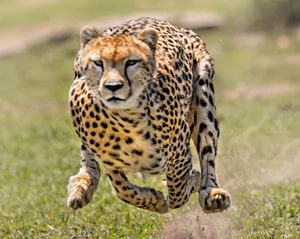English Documentary on Cheetahs with Transcript and illustrated flashcards inside the transcript to improve your listening and reading comprehension and expand your vocabulary
Source of documentary: National Geographic YouTube Channel
The fastest land animals
You probably already know they’re the world’s fastest land animal. They can go from zero to sixty in three seconds covering the length of an Asian elephant with each stride. But here are five things you probably didn’t know about cheetahs.
Chirping creatures
Cheetahs are one of the few big cats that can’t roar. Instead, these carnivores purr much like a house cat. Also they chirp loudly enough to be heard a mile away. These chirps vary from cheetah to cheetah. One theory is that this may allow them to identify each other.
Having protracted claws
Cheetahs are the only big cat that can’t fully retract their claws. Acinonyx jubatus is the cheetah’s scientific name. Acinonyx means no-move-claw in Greek. Their claws are actually more similar to a dog’s than to those of other cats helping cheetahs maintain traction and gain speed while running.
The Helpful tail
Their muscular tail which can be over two and a half feet long helps cheetahs when they’re hunting prey. The tail acts like a radar allowing cheetahs to quickly change direction while running. It provides counterbalance as they zigzag across grasslands during a chase.
A different big cat with a different eyesight
Unlike other big cats, cheetahs hunt primarily by day relying on their exceptionally keen eyesight. Dark tear marks below cheetahs’ eyes may help reduce glare from the Sun, much like that eye black that some professional athletes wear. Without the cover of darkness, cheetahs camouflage themselves in the tall grass of the Savanna typically getting as close as a football field’s width away from their prey before making the chase.
The homeland and population
While most cheetahs live in Africa, a subspecies of the big cat lives in central Iran. These Asiatic cheetahs are genetically distinct from their African counterparts. Unfortunately, they’re critically endangered with only an estimated 50 individuals remaining. The cheetah population has declined from an estimated 100,000 in the early 1900s to around 7,000 today, according to recent estimates.
Cheetahs are under thread from humans. Poaching, habitat loss and vehicle collisions have contributed to their decline plus humans hunt antelopes, warthogs and other prey spices that cheetahs rely on. In Namibia, farmers sometimes shoot cheetahs in retaliation for livestock killings. One successful conservation program involves placing livestock guarding dogs with farmers. The dogs scare away these big cats which are built more for speed than fighting.




Humanity is destroying evrithing for real and it is annoying for real.
I can’t believe that.
It’s better to write “human activities” or “humans” instead of “humanity”, which is something else. However, I agree with you on the detrimental effects of human activities on the environment and wildlife.
Cheetahs are truly one of the most elegant and fascinating animals in the world. I hope we soon find a way to protect them from extinction.
Cheetahs have agile and lithe bodies, and therefore, their velocity is technically ahead of their peers. With their mesmerizing appearance, coloration, and superb speed, cheetahs’ prey don’t have a big chance of running away from these wild cats.
The fastest land animals
You probably already know they’re the world’s fastest land animal. They can go from zero to sixty and three seconds covering the length of an Asian elephant with each stride but here are five things you probably didn’t know about cheetahs.
Chirping creatures
Cheetahs are one of the few big cats that can’t roar, instead these carnivores purr much like a house cat. Also they chirp loudly enough to be heard a mile away. These chirps vary from cheetah to cheetah. One theory is that this may allow them to identify each other.
Having protracted claws
Cheetahs are the only big cat that can’t fully retract their claws. Acinonyx Jubatus is the cheetah’s scientific name. Acinonyx means no-move-claw in Greek. Their claws are actually more similar to a dog’s than to those of other cats helping cheetahs maintain traction and gain speed while running.
The Helpful tail
Their muscular tail which can be over two and a half feet long helps cheetahs when they’re hunting prey. The tail acts like a radar allowing cheetahs to quickly change direction while running. It provides counterbalance as they zigzag across grasslands during a chase.
A different big cat with a different eyesight
Unlike other big cats, cheetahs hunt primarily by day relying on their exceptionally keen eyesight. Dark tear marks below cheetahs’ eyes may help reduce glare from the Sun, much like that eye black that some professional athletes wear. Without the cover of darkness cheetahs camouflage themselves in the tall grasses of the Savanna typically getting as close as a football field’s width away from their prey before making the chase.
The homeland and population
While most cheetahs live in Africa, a subspecies of the big cat lives in central Iran. These Asiatic cheetahs are genetically distinct from their African counterparts. Unfortunately, they’re critically endangered with only an estimated 50 individuals remaining. The cheetah population has declined from an estimated 100,000 in their early 1900s to around 7,000 today according to recent estimates. Cheetahs are under thread from humans. Poaching, habitat loss and vehicle collisions have contributed to their decline plus humans hunt antelopes, warthogs and other prey spices that cheetahs rely on. In Namibia, farmers sometimes shoot cheetahs in retaliation for livestock killings. One successful conservation program involves placing livestock guarding dogs with farmers. The dogs scare away theses cats which are built more for speed than fighting.
Thanks so much for your transcription. The following errors have occurred in your task in order of their occurrences:
1. … sixty in 3 second
2. in the tall grass of the Savanna
3. in the early 1990s
4. scare away these big cats